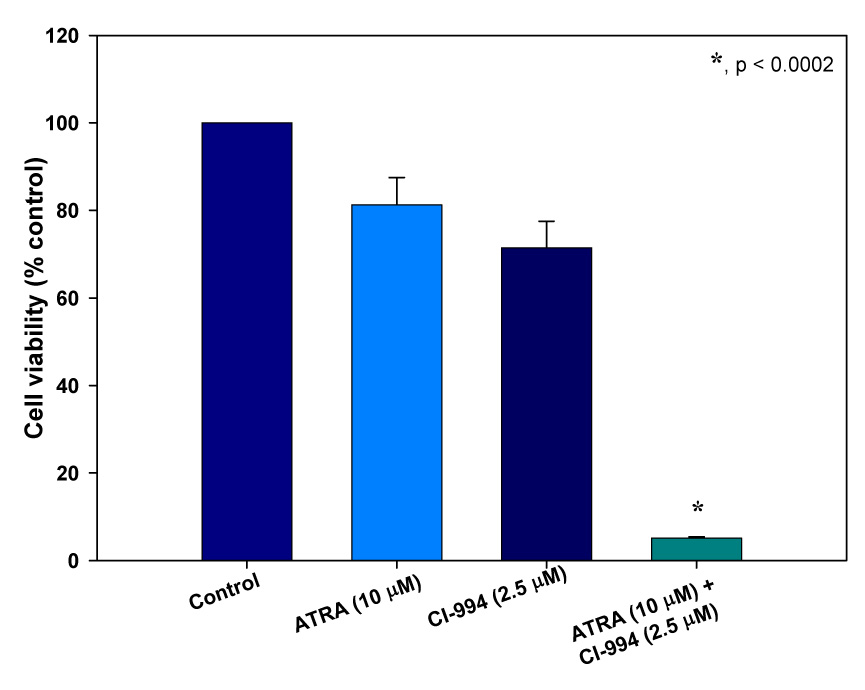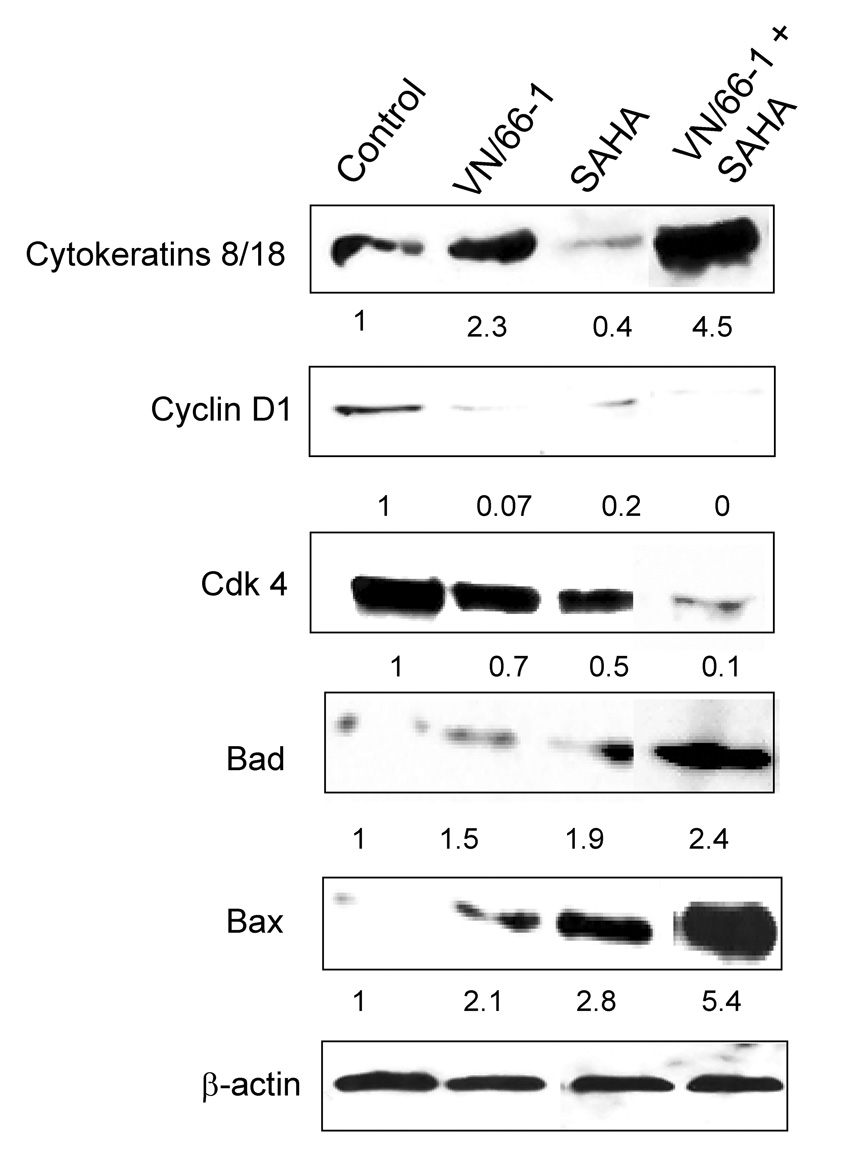
| Size | Price | Stock | Qty |
|---|---|---|---|
| 25mg |
|
||
| 50mg |
|
||
| 100mg |
|
||
| 250mg |
|
||
| 500mg |
|
||
| 1g |
|
||
| Other Sizes |
Purity: ≥98%
Tacedinaline (GOE5549, PD123654, CI994; Acetyldinaline) is a potent, orally bioavailable and selective inhibitor of histone deacetylase 1/3 (HDAC1/3) with potential anticancer activity. It has IC50s of 0.9, 0.9, and 1.2 μM for HDAC1/2/3 inhibition, respectively.
| Targets |
HD1 ( IC50 = 0.9 μM ); HD2 ( IC50 = 0.9 μM ); HD3 ( IC50 = 1.2 μM )
|
|
|---|---|---|
| ln Vitro |
|
|
| ln Vivo |
|
|
| Enzyme Assay |
Tacedinaline, also known as N-acetyldinaline, has IC50 values of 0.9, 0.9, and 1.2 μM for recombinant HDAC 1, 2, and 3, respectively, making it an inhibitor of histone deacetylase (HDAC).
|
|
| Cell Assay |
The whole culture medium of RPMI 1640 medium, which includes 10% fetal bovine serum, 1% penicillin, and 1% streptomycin, is used to maintain LNCaP cell lines. 24-well plates are seeded with 2×104 cells, which are then incubated for one day at 37 °C in an incubator with 5% CO2. On days two and four, cultures are treated with CI-994 both alone and in combination. On days two and four, media are replaced and cells are cleaned. As a gauge of cell proliferation, mitochondrial metabolism is assessed by introducing 100 μL/well MTT (5 mg/mL in medium) and incubating it for two hours at 37 °C on Day 6. Dissolved crystals are placed in 500 μL of DMSO. At 560 nm, the absorbance is measured with a microplate reader. The percentage of cell proliferation is calculated from the absorbance data. Three duplicates of each assay are run.
|
|
| Animal Protocol |
|
|
| References | ||
| Additional Infomation |
Tacedinaline is a benzamide obtained by formal condensation of the carboxy group of 4-acetamidobenzoic acid with one of the amino groups of 1,2-phenylenediamine. An oral cytostatic drug with impressive differential activity against leukemic cells and normal stem-cells. Also used in combination therapy for selected tumors including non-smoll cell lung, pancreatic, breast, and colorectal cancers. It has a role as an EC 3.5.1.98 (histone deacetylase) inhibitor and an antineoplastic agent. It is a member of acetamides, a member of benzamides and a substituted aniline. It is functionally related to a 1,2-phenylenediamine.
Tacedinaline has been used in trials studying the treatment of Lung Cancer, Multiple Myeloma, and Pancreatic Cancer. Acetyldinaline is under investigation in clinical trial NCT00005624 (CI-994 in Treating Patients With Advanced Myeloma). Tacedinaline is an orally bioavailable substituted benzamide derivative with potential antineoplastic activity. Tacedinaline inhibits histone deacetylation, which may result in histone hyperacetylation, followed by the induction of differentiation, the inhibition of cell proliferation, and apoptosis in susceptible tumor cell populations. |
| Molecular Formula |
C15H15N3O2
|
|
|---|---|---|
| Molecular Weight |
269.3
|
|
| Exact Mass |
269.116
|
|
| Elemental Analysis |
C, 66.90; H, 5.61; N, 15.60; O, 11.88
|
|
| CAS # |
112522-64-2
|
|
| Related CAS # |
|
|
| PubChem CID |
2746
|
|
| Appearance |
Off-white solid powder
|
|
| Density |
1.3±0.1 g/cm3
|
|
| Boiling Point |
450.6±30.0 °C at 760 mmHg
|
|
| Melting Point |
242 °C(dec.)
|
|
| Flash Point |
226.3±24.6 °C
|
|
| Vapour Pressure |
0.0±1.1 mmHg at 25°C
|
|
| Index of Refraction |
1.707
|
|
| LogP |
0.96
|
|
| Hydrogen Bond Donor Count |
3
|
|
| Hydrogen Bond Acceptor Count |
3
|
|
| Rotatable Bond Count |
3
|
|
| Heavy Atom Count |
20
|
|
| Complexity |
351
|
|
| Defined Atom Stereocenter Count |
0
|
|
| SMILES |
O=C(C1C([H])=C([H])C(=C([H])C=1[H])N([H])C(C([H])([H])[H])=O)N([H])C1=C([H])C([H])=C([H])C([H])=C1N([H])[H]
|
|
| InChi Key |
VAZAPHZUAVEOMC-UHFFFAOYSA-N
|
|
| InChi Code |
InChI=1S/C15H15N3O2/c1-10(19)17-12-8-6-11(7-9-12)15(20)18-14-5-3-2-4-13(14)16/h2-9H,16H2,1H3,(H,17,19)(H,18,20)
|
|
| Chemical Name |
4-acetamido-N-(2-aminophenyl)benzamide
|
|
| Synonyms |
|
|
| HS Tariff Code |
2934.99.9001
|
|
| Storage |
Powder -20°C 3 years 4°C 2 years In solvent -80°C 6 months -20°C 1 month |
|
| Shipping Condition |
Room temperature (This product is stable at ambient temperature for a few days during ordinary shipping and time spent in Customs)
|
| Solubility (In Vitro) |
|
|||
|---|---|---|---|---|
| Solubility (In Vivo) |
Solubility in Formulation 1: ≥ 2.5 mg/mL (9.28 mM) (saturation unknown) in 10% DMSO + 40% PEG300 + 5% Tween80 + 45% Saline (add these co-solvents sequentially from left to right, and one by one), clear solution.
For example, if 1 mL of working solution is to be prepared, you can add 100 μL of 25.0 mg/mL clear DMSO stock solution to 400 μL PEG300 and mix evenly; then add 50 μL Tween-80 to the above solution and mix evenly; then add 450 μL normal saline to adjust the volume to 1 mL. Preparation of saline: Dissolve 0.9 g of sodium chloride in 100 mL ddH₂ O to obtain a clear solution. Solubility in Formulation 2: 30% PEG400+0.5% Tween80+5% propylene glycol: 30mg/mL (Please use freshly prepared in vivo formulations for optimal results.) |
| Preparing Stock Solutions | 1 mg | 5 mg | 10 mg | |
| 1 mM | 3.7133 mL | 18.5667 mL | 37.1333 mL | |
| 5 mM | 0.7427 mL | 3.7133 mL | 7.4267 mL | |
| 10 mM | 0.3713 mL | 1.8567 mL | 3.7133 mL |
*Note: Please select an appropriate solvent for the preparation of stock solution based on your experiment needs. For most products, DMSO can be used for preparing stock solutions (e.g. 5 mM, 10 mM, or 20 mM concentration); some products with high aqueous solubility may be dissolved in water directly. Solubility information is available at the above Solubility Data section. Once the stock solution is prepared, aliquot it to routine usage volumes and store at -20°C or -80°C. Avoid repeated freeze and thaw cycles.
Calculation results
Working concentration: mg/mL;
Method for preparing DMSO stock solution: mg drug pre-dissolved in μL DMSO (stock solution concentration mg/mL). Please contact us first if the concentration exceeds the DMSO solubility of the batch of drug.
Method for preparing in vivo formulation::Take μL DMSO stock solution, next add μL PEG300, mix and clarify, next addμL Tween 80, mix and clarify, next add μL ddH2O,mix and clarify.
(1) Please be sure that the solution is clear before the addition of next solvent. Dissolution methods like vortex, ultrasound or warming and heat may be used to aid dissolving.
(2) Be sure to add the solvent(s) in order.
| NCT Number | Recruitment | interventions | Conditions | Sponsor/Collaborators | Start Date | Phases |
| NCT00005624 | Completed | Drug: CI-994 | Multiple Myeloma | H. Lee Moffitt Cancer Center and Research Institute |
August 1997 | Phase 2 |
| NCT00005093 | Completed | Drug: gemcitabine hydrochloride Drug: tacedinaline |
Lung Cancer | Pfizer | December 1999 | Phase 3 |
| NCT00004861 | Completed | Drug: gemcitabine hydrochloride Drug: tacedinaline |
Pancreatic Cancer | Pfizer | October 1999 | Phase 2 |
 |
 |